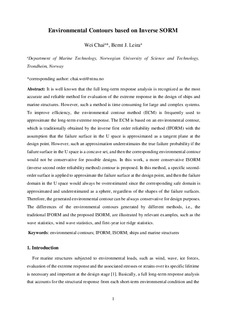Environmental contours based on inverse SORM
Journal article
Submitted version
Permanent lenke
http://hdl.handle.net/11250/2492033Utgivelsesdato
2018Metadata
Vis full innførselSamlinger
- Institutt for marin teknikk [3469]
- Publikasjoner fra CRIStin - NTNU [38525]
Sammendrag
It is well known that the full long-term response analysis is recognized as the most accurate and reliable method for evaluation of the extreme response in the design of ships and marine structures. However, such a method is time consuming for large and complex systems. To improve efficiency, the environmental contour method (ECM) is frequently used to approximate the long-term extreme response. The ECM is based on an environmental contour, which is traditionally obtained by the inverse first order reliability method (IFORM) with the assumption that the failure surface in the U space is approximated as a tangent plane at the design point. However, such an approximation underestimates the true failure probability if the failure surface in the U space is a concave set, and then the corresponding environmental contour would not be conservative for possible designs. In this work, a more conservative ISORM (inverse second order reliability method) contour is proposed. In this method, a specific second-order surface is applied to approximate the failure surface at the design point, and then the failure domain in the U space would always be overestimated since the corresponding safe domain is approximated and underestimated as a sphere, regardless of the shapes of the failure surfaces. Therefore, the generated environmental contour can be always conservative for design purposes. The differences of the environmental contours generated by different methods, i.e., the traditional IFORM and the proposed ISORM, are illustrated by relevant examples, such as the wave statistics, wind wave statistics, and first-year ice ridge statistics.
